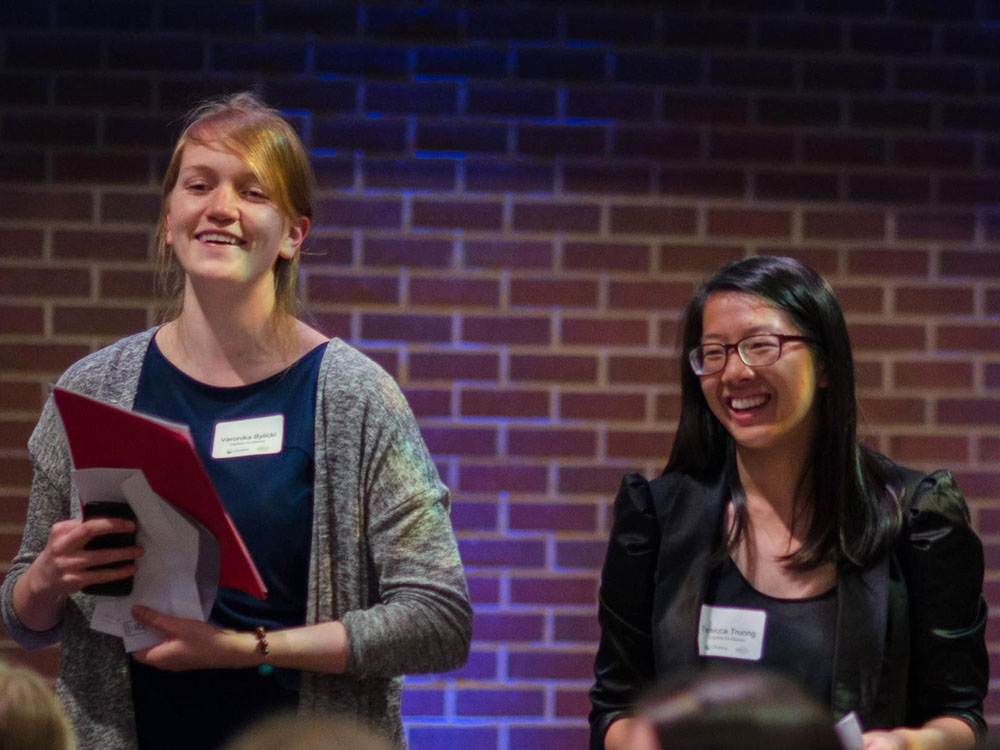Forget the myths that millennials are lazy or disengaged, says CityHive co-founder Tesicca Truong.
“We’re the most engaged generation. We volunteer our time more than anyone else,” she says. “It’s just in the political system that young people aren’t engaging.”
But that’s a problem too, says Truong, as cities are missing out on young people’s input, ideas and energy.
Since high school, Truong and Veronika Bylicki, CityHive’s other cofounder, have been working to increase young people’s involvement in civic and sustainability issues.
Their work was recently recognized by the Real Estate Foundation of BC with its 2018 Emerging Leader Award, shared between the two.
“Being recognized together is really neat, given that the award is meant for an individual,” says Bylicki. “As a women-founded and led organization, it’s neat to be able to model working together and lifting each other up instead of being competition.”
They started by organizing a sustainability conference in high school — a project later adopted by the Vancouver School Board — and have kept on engaging youth in civic and sustainability issues.
Truong and Bylicki, both 24, said they noticed their peers were eager to be involved in these areas, but most didn’t know how cities operate or how they could participate — and that cities lacked opportunities for young people to be involved.
So two years ago Truong and Bylicki founded CityHive, a non-profit organization aimed at increasing involvement.
“It really emerged out of this need we saw in the city, that young people wanted to be involved and have an impact on their communities, and at the same time cities really needed their help,” Truong says. “They have these ambitious goals and wicked challenges around sustainability, but cities can’t solve them without citizen power. That’s where CityHive came in. We act like a bridge builder between cities and young people who want to get involved.”
Part of their strategy is to draw young people into civic processes and help take their good ideas from concept to reality.
To increase civic literacy among youth they’ve hosted, among other things, an urban design bike tour and an ask-anything pre-election party.
“We need to understand the system we’re a part of before we can try to change it,” Truong says. Once people have a better idea of how things operate, they can come up with ideas for how to make communities better for all.
The first program they started was 30Network, which brings together a cohort of 30 people under 30 to work on urban issues.
The group learns about a particular issue together — the first year they focused on affordable housing; this year it’s civic engagement — and come up with ideas and solutions.
They then present them to local political and community leaders, and by the end of the program ideas are launched with community partners.
This year eight projects geared towards civic engagement were started, with focuses from encouraging first-time voters to supporting young people with mental health barriers so they could vote confidently and independently.
CityHive also works directly with civic institutions that are missing out on youth input.
They consult with municipalities to design youth engagement strategies, and have made sure youth participated in consultations where their voices weren’t being heard.
For example, last year Natural Resources Canada ran a nation-wide consultation on the future of energy in Canada — but they weren’t getting young people involved.
So, with another organization, CityHive trained young people to lead dialogues across Canada. They all gathered for a summit where they collaborated on a report and presented it to Natural Resources Minister Jim Carr in a panel discussion.
“It was a really powerful moment,” Truong recalls. “Like, wow, this is exactly what we set out to do, to engage people with policy making in its development proactively, versus reactively after the fact.”
At a local level, they’re encouraging municipalities to consider who normally shows up for consultations and public meetings, who doesn’t, and why.
“At community open houses we started seeing that most people in the room were retired, or maybe were homeowners. Lots of demographics weren’t there,” Bylicki says. “Why is that and how can we change it?”
In just two years, they’ve not only put youth engagement on the table, they’ve developed a model showing how to do it.
“It feels like we’ve filled a gap and built a bridge that wasn’t there beforehand. Now, when municipalities are looking at the work that they do, they think to bring us in,” Bylicki says. “With youth engagement specifically, you’re actually building a habit, so that engagement isn’t just an afterthought, it’s as common as breathing.”
Truong and Bylicki are young people themselves. Despite accolades and awards, they still have to work through the difficulties of gaining trust from older people.
“The same barriers we’re trying to break down for others, we often face as two young women in leadership,” Truong says. “Those questions around credibility, of being younger, and being women, and also for myself being a person of colour. Those really come in to play, especially with large-scale funding or institutional support.”
Overcoming these challenges took lots of hard work and support from mentors. The first conference they organized in high school happened because a teacher chose to “lead from behind,” as Truong puts it. That experience and others gave them the space to develop their leadership skills.
“I couldn’t even count on both my hands and all my toes all the amazing mentors who have trusted us, and offered their support and mentorship,” Truong says. ![]()
This article is part of a Tyee Presents initiative. Tyee Presents is the special sponsored content section within The Tyee where we highlight contests, events and other initiatives that are either put on by us or by our select partners. The Tyee does not and cannot vouch for or endorse products advertised on The Tyee. We choose our partners carefully and consciously, to fit with The Tyee’s reputation as B.C.’s Home for News, Culture and Solutions. Learn more about Tyee Presents here.

















Tyee Commenting Guidelines
Comments that violate guidelines risk being deleted, and violations may result in a temporary or permanent user ban. Maintain the spirit of good conversation to stay in the discussion.
*Please note The Tyee is not a forum for spreading misinformation about COVID-19, denying its existence or minimizing its risk to public health.
Do:
Do not: